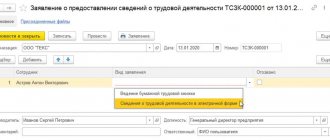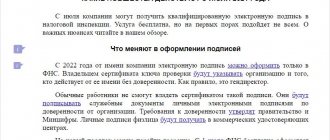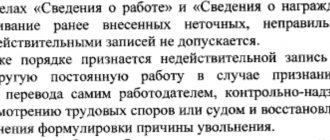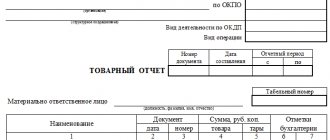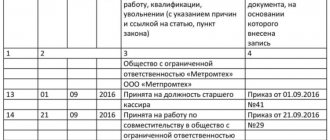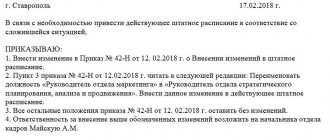HR records management is a complex and multifunctional process, which is regulated by the legislation of the Russian Federation and requires proper documentation. Therefore, it is very important that this process is handled by a full-time HR specialist who has the relevant experience.
However, there are cases when an organization does not have a full-time personnel officer and accountants, secretaries, and office managers are involved in preparing personnel documents.
In a small organization, the functions of preparing personnel documents can be performed by the manager himself - in this case, additional documentation is not required, since in accordance with the organization’s charter, the manager is responsible for any aspect of the organization’s activities.
Why do we need an order on the person responsible for maintaining the Labor Code?
The work book contains information about the work process and length of service of employees (Part 1 of Article 66 of the Labor Code of the Russian Federation). The procedure for collecting data on the working period in electronic form is provided for in Art. 66.1 TK. Since these documents are one of the main grounds for the future pension of employees, the law establishes strict rules for working with Labor Codes. They are enshrined in government decree No. 225 dated April 16, 2003.
The regulatory act states that the employer is responsible for the correct completion, storage and accounting of labor codes. He is obliged to provide conditions for safe storage in a strictly designated place in accordance with the requirements of the law. To perform this important task, the manager issues an order which of the company employees is obliged to ensure their safety, fill out and give employees all the information on them. This is provided for in paragraph 45 of the rules. The same applies to maintaining digital records of employee labor data. It is necessary to issue an order appointing someone responsible for maintaining electronic work books, in which a specific specialist is assigned new functions. Among the main tasks of performing work on digital recording of work activities:
- generating reports in the SZV-TD form and sending them to the Pension Fund of Russia;
- processing workers' applications for the preferred labor code option;
- issuing statements, certificates, etc.
Do you need an order for electronic work books?
2020 will mark the beginning of the transition from paper work books to their electronic versions. As of January 1, 2020, changes to the Labor Code regarding this procedure came into effect. Until October 31, 2020, employers must:
- notify staff that information about length of service will now be stored electronically by the Pension Fund;
- invite employees to choose between a paper book or an electronic one.
In this regard, a company or individual entrepreneur may need to issue orders and adopt new local regulations, which will set out the rules for generating information about labor activity in electronic form. The orders will regulate all actions of the enterprise’s employees regarding the transition to the new labor format.
Read on to learn how to place such an order.
And how to make changes to local regulations is discussed in detail in the material “How to make changes to local regulations, including PVTR” of the Guide from ConsultantPlus, to which you can get free access.
Who writes the order for the appointment of a specialist to work with TC
In each company, an order appointing a person responsible for maintaining, storing, recording and issuing work books is drawn up on behalf of the director. But the executor is a lawyer, office manager, clerk or other employee. But it doesn’t matter who is doing it, since the final word always remains with the leader. The order will acquire legal force only after it is endorsed by the director.
The question remains at the discretion of the manager as to who should be assigned the responsibilities for maintaining the Labor Code. Typically, HR documentation is handled by a HR specialist. But not necessarily. If the company is small and there is no HR department, then they appoint another employee who can keep records of documents - a secretary, an accountant. After transferring the TC to digital accounting, entering information about professional activities is often transferred to accounting employees, who generate electronic reports and transmit them to the Pension Fund.
To hire a personnel officer, it is enough to issue an order, since these functions are specified in his contract and job description. If these tasks are assigned, for example, to a secretary or an accounting employee, then changes will have to be made to the job description to appoint someone responsible for maintaining work records at the enterprise.
IMPORTANT!
If the authorized person changes, the previous specialist is obliged to draw up an acceptance certificate and transfer all technical documentation to the receiver. In this case, it is not enough to note only the number of these documents; the personal data of their owners should be indicated.
Why do you need an order?
By law, work books belong to strict reporting forms. This is due to the fact that they contain information that subsequently directly affects the level of pension of a particular employee, so work with them must be carried out in a certain order. This is especially true for large organizations, where there are a large number of hired personnel, and therefore a large flow of personnel documentation.
The head of the enterprise personally appoints an employee who is responsible for the safety of work records. This is usually an employee or head of the HR department.
The responsibilities of this specialist include not only receiving and issuing labor documents and inserts for them, but also filling them out, taking care of their contents and accounting.
In the event of loss or damage to the work document, the responsible employee will have to restore the document (or compensate for the costs of this procedure).
Features of the document
There is no standard uniform template for an order imposing labor duties in the legislation. They write it on a computer in any form, focusing on the rules of GOST R 7.0.97-2016. Draw it up on the traditional letterhead accepted by the company. If it is not there, then on a regular A4 sheet.
Follow the basic requirements:
- In the header of the document, indicate the name of the company, location, registration codes (TIN, KPP, OGRN).
- Below on the left write the date and registration number. On the right is the place where the act was issued.
- In the middle is the title of the document (“Order on...”).
- Administrative part.
- Director's signature.
- Signatures of employees familiar with the document.
- Stamp (if accepted by the organization).
The act is drawn up in one copy. In the content, after the word “I order...”, be sure to indicate on what basis the document was issued (check the details of legislative acts, in our case, clause 45 of PP No. 225). In the text, specify the responsible person (full name, position). In the next paragraph, write down who is required to perform the functions when the main specialist is absent due to a business trip, temporary disability and other valid reasons. Place your full name below. employees who will familiarize themselves with the order against signature. After publication, register the document in the registration journal.
ConsultantPlus experts figured out how to store work records. Use these instructions for free.
New rules for maintaining work books
According to the generally accepted opinion, any newly adopted document regulating vital issues of a significant part of society evokes a feeling of hope that it will bring more clarity and eliminate ambiguous interpretations or obvious errors. It was the same now. But despite the unconditional presence in the new Procedure of clarifications on previously unaddressed issues, some of the problems remained unresolved. Moreover, new ones have appeared.
Unaddressed problems include the following:
1. The Ministry of Labor of Russia has not brought order to the terminology with the concepts of “terminated”, “dissolved”, “dismissed”. The reason, apparently, is that previously opposite answers were given to requests from personnel services about how to correctly make an entry in the work book upon termination of the employment relationship. According to the “golden rule” of personnel records, most specialists decided that the entry must correspond to the text of the order, and the order must correspond to the text of the law. Therefore, entries about the termination of an employment contract for one reason or another began to appear more and more often in work books.
However, in the theory of labor law, the concept of “termination” is considered as a procedure where there is an initiator and a set of necessary actions provided for by law that have a time frame. For example, an employee writes a resignation letter of his own free will and, as a general rule, works for 2 weeks. But if there are good reasons, he works only 3 days or does not work at all and receives pay and work on the day the application is submitted. Another example is that termination of an employment relationship due to a reduction in headcount or staffing will, as a general rule, be carried out within 2 months, although exceptions are possible (consent of the employee).
It is important to understand here that termination is a process that 1) begins on someone’s initiative, 2) has a legally prescribed sequence of actions by the parties, and 3) they are always limited to certain time limits. Why include in work books what is classified as procedures? There should only be their result - dismissal (with reference to the relevant subclause, paragraph, part of the article and article of the law). We use the term “termination” only when there is no will of the parties to the relationship, as is expressly provided for in clause 19 of the Procedure. According to it, when an employment contract is terminated due to circumstances beyond the control of the parties, an entry is made in the work book about the grounds for termination of the employment contract with reference to the corresponding paragraph of Part 1 of Art. 83 Labor Code of the Russian Federation. This wording can lead to serious problems when filling out work books. On the one hand, it is clear when to use the term “termination”; on the other hand, personnel services may mistakenly refer to the specified article when filling out the book. 83 Labor Code of the Russian Federation. But all the grounds listed in Art. 83 of the Labor Code of the Russian Federation, must be drawn up with reference to clause 10, part 1, art. 77 Labor Code of the Russian Federation.
It is a pity that the Russian Ministry of Labor did not bother to provide precise examples of at least the main, most frequently used grounds for termination of an employment contract. However, in clauses 15–19 of the Procedure, the concept of “dismissal (termination of an employment contract)” is in meaning opposed to the concept of “termination”, since termination implies the presence of initiative of one of the parties to the employment relationship.
2. Clause 20 of the Order aggravates a problem that should have been corrected long ago in Part 5 of Art. 84.1 of the Labor Code of the Russian Federation (“if an employment contract is terminated for other reasons... an entry about dismissal (termination of the employment contract) is made in the work book with reference to the relevant article, part of the article, paragraph of the article of the Labor Code of the Russian Federation or other federal law”). Moreover, the same error will now appear in the text of the work book form! But experts have repeatedly pointed out the incorrect sequence of references to the law. The Labor Code of the Russian Federation violates the general legal practice of referring to subparagraphs, clauses and articles of the Code. Although in Part 6 of Art. 84.1 of the Labor Code of the Russian Federation provides examples in the correct sequence generally accepted in legislation and law enforcement practice.
3. Experts expressed concern about the problem of entering information into the work book in connection with amendments to the education . Everyone hoped that this issue would be resolved during the development of new work record forms. But this did not happen. Workers with bachelor's or master's degrees have not been given the opportunity to have a record corresponding to their diploma.
4. There remains a problem with entering the name of the organization into the work book. In para. 1 clause 10 of the Procedure states that “in column 3 of the “Information about work” section of the work book, the full name of the organization, as well as the abbreviated name of the organization (if any) is indicated as a heading.” It should be clarified that the abbreviated name of the organization can be used in the text of the work book only if it is included in the organization’s charter. HR staff typically do not receive professional legal training to know these intricacies.
5. The clause on recording part-time certainly brought its advantages to resolving a long-standing problem. But it wasn't without additional problems. Paragraph 2 clause 11 of the Procedure allows an entry to be made about part-time work in cases where part-time work took place before employment with the employer whose work is the main one for the employee. However, according to Art. 60.1 of the Labor Code of the Russian Federation, an employee has the right to enter into employment contracts to perform other regular paid work for the same or another employer in his free time from his main job. It turns out that before employment with an employer whose work is the main one for the employee, any other job for him was not part-time.
6. There remains one more significant problem. On the one hand, the procedures for registering an entry in the work book upon dismissal in the order of transfer are correctly described, the need is emphasized not only to correctly refer to the relevant norms in the Labor Code of the Russian Federation, but also to indicate where the employee is leaving in the order of transfer. On the other hand, in para. 2 clause 21 The order in the employment record was not added, from where the employee comes to the organization in the order of this transfer.
Upon dismissal from organization “A”, the work book must indicate that he was dismissed by way of transfer to organization “B”, and in organization “B” it must be entered in the work book that he was hired by way of transfer from organization “B”. A". In practice, there are cases when an employee, during the transition process, changes his mind and finds employment in organization “C”. The Labor Code of the Russian Federation provides for freedom of labor, and the employee can change his mind and not notify anyone, but in the work book, the entry on admission to organization “C” will explain that the transfer did not take place and there was an ordinary dismissal of his own free will.
At first glance, nothing terrible happened. But the legislator, the judiciary and the Russian Ministry of Labor itself constantly remind that not all reasons for dismissal are of equal value. In addition to guilty and innocent reasons for dismissal at the initiative of the employer, there are also valid and disrespectful reasons for dismissal at one’s own request. This is expressly stated in paragraph. 2 clause 17 of the Procedure: “when an employment contract is terminated at the initiative of the employee on the grounds provided for by the legislation of the Russian Federation, which are associated with the provision of certain benefits and advantages, an entry about the dismissal (termination of the employment contract) is made in the work book indicating these grounds.”
The reasons not only influence a person’s career development, but are also considered when assigning unemployment benefits. If an employee cannot find a job and turns to the employment service, the reason for dismissal is important when deciding the amount of benefits. Thus, dismissal by transfer refers to valid reasons for dismissal (if he moved from “A” to “B”). But if the employee did not move, as planned, to organization “B”, but got a job at “C”, then this is considered as dismissal of his own free will without good reason. Under previous rules, repeated dismissal without good reason within a year would have interrupted his employment. Now the personnel service receiving the documents will be able to think about the candidate’s business qualities and his ability to keep his word and bear obligations to another employer, where, by law, he had to wait a whole month.
Sample
Here is a template for an order on the person responsible for storing work records in an organization in 2022, which you have the right to use as a basis when filling out.
| Limited Liability Company _____________ Address___________ tel/fax ____________ OGRN / OKPO ___________ Taxpayer Identification Number/KPP ______________________________ Order No.____ |
On the appointment of employees for maintaining, storing and recording technical documentation
In connection with paragraph 45 of the rules approved by Government Decree No. 225 of April 16, 2003,
I ORDER:
- Appoint someone responsible for maintaining and recording work books _____________ (position, full name).
- During the absence, full name assign these tasks to _________ (position, full name).
- I reserve control over the execution of the order.
Supervisor
/__signature______/_decryption
The following have been familiarized with the order:
/__signature______/_decryption
/_signature_______/_decryption
And this is a sample of filling out an order for the appointment of a person responsible for maintaining work books in a preschool educational institution, including accounting for electronic labor records.
How to write an order correctly
There is no unified form; the document is drawn up in any form.
Step 1. Complete it on the organization’s letterhead. If it is missing, please indicate the basic details at the top: name, location, registration codes.
Step 2. Enter the date, serial number and place of registration. Write the name - “Order”. On the next line is the reason-content “On the appointment of a person responsible for maintaining, storing, recording and issuing work books.”
Step 3. In the introductory part, make a link to the legal act regulating the content - clause 45 of the rules for maintaining the Labor Code (RF Government Decree No. 225 as amended on March 25, 2013).
Step 4. After the word “I order,” list the manager’s orders:
- appointment of an authorized employee - indicate the position, the basis for the introduction of authority (for example, a link to a clause in the employment contract or job description);
- appointment of an employee during the absence of the responsible person - indicate the position and conditions of performance (for example, the form and amount of monetary compensation);
- write who monitors execution.
Step 5. Enter space for the manager's signature.
Step 6. List the employees who are mentioned in the text - they will sign after reading the content.
What to pay attention to:
- in the content, if necessary, include those responsible for the entire organization as a whole and for individual structural units;
- Do not write down the operating rules or a detailed list of the duties of the authorized person. They are in the employment contract, job description or other local regulatory act (for example, in the regulation on the maintenance and storage of technical documentation).
This is what a sample order for maintaining work records and appointing a person in charge looks like:
| State budgetary educational institution for additional education of children specialized children's and youth sports school of Olympic reserve "Allur" 123456, Moscow, 3rd Budget Proezd, 1, TIN 123456789876, OGRN 1234567898765 ORDER No. 45-LS |
On the appointment of persons responsible for maintaining, storing, recording and issuing technical documentation
In pursuance of paragraph 45 of the Rules for maintaining and storing work books, producing forms and providing them to employers, approved by Government Decree No. 225 of April 16, 2003,
I ORDER:
- Appoint HR specialist V.V. Voloshin, and in her absence HR Manager S.S. Smirnov responsible for maintaining, storing, recording and issuing work books of employees.
- Control over the execution of the order is entrusted to the head of the personnel department A.A. Alexandrov.
30.05.2020
Director: Ivanov I.I.S.
The order has been reviewed by: Aleksandrova A.A.
Voloshina V.V.
Smirnova S.S.
And here is a sample order on the transition to electronic books and submission of information about work activities in electronic form. The main content is that a responsible person is appointed and new functions of the employee are determined in connection with the implementation of Federal Law-439 of December 16, 2019:
- notifications and explanations to staff about innovations in relation to work books;
- collecting applications from employees of the organization about the transition to the ETC;
- preparation of the SZV-TD report for the Pension Fund and information in the SZI-TD form.
| State budgetary educational institution for additional education of children specialized children's and youth sports school of Olympic reserve "Allur" 123456, Moscow, 3rd Budget Proezd, 1, TIN 123456789876, OGRN 1234567898765 ORDER No. 45-LS |
On the transition to electronic information on the work activities of employees and the appointment of responsible persons for the period until December 31, 2020
I ORDER:
1. Appoint the head of the HR department to A.A. Aleksandrova. responsible for:
- preparation of information on the activities of employees in the SZV-TD form and submission to the Pension Fund of Russia;
- preparation of information about activities in the SZI-TD form and issuing them to employees.
2. Appoint a HR specialist V.V. Voloshin responsible for:
- notification to employees of the organization about innovations in relation to electronic work books and about the possibility of choosing an option for maintaining them until 06/30/2020 (inclusive);
- collecting applications from employees to refuse or to continue maintaining a work record book on paper until December 31, 2020 (inclusive).
3. I reserve control over the execution of the order.
31.12.2019
Director: Ivanov I.I.S.
The order has been reviewed by: Aleksandrova A.A.
Voloshina V.V.

